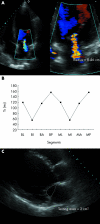Role of regional mechanical dyssynchrony as a determinant of functional mitral regurgitation in patients with left ventricular systolic dysfunction
- PMID: 16449509
- PMCID: PMC1861021
- DOI: 10.1136/hrt.2005.082115
Role of regional mechanical dyssynchrony as a determinant of functional mitral regurgitation in patients with left ventricular systolic dysfunction
Abstract
Objective: To assess regional mechanical dyssynchrony as a determinant of the degree of functional mitral regurgitation (FMR).
Setting: Tertiary cardiology clinic.
Patients: 74 consecutive patients with left ventricular (LV) dysfunction (ejection fraction < 40%, mean 32.2 (SD 7.3)%) were evaluated.
Methods: Effective regurgitant orifice (ERO) area, indices of mitral deformation (systolic valvular tenting, mitral annular contraction) and of global LV function and remodelling (ejection fraction, end systolic volume, sphericity index) and local remodelling (papillary-fibrosa distance, regional wall motion score index), and tissue Doppler-derived dyssynchrony index (DI) (regional DI, defined as the standard deviation of time to peak myocardial systolic contraction of eight LV segments supporting the papillary muscles attachment) were measured.
Results: All the assessed variables correlated significantly with ERO. By multivariate analysis, systolic valvular tenting was the strongest independent predictor of ERO (R(2) = 0.77, p = 0.0001), with a minor influence of papillary-fibrosa distance (R(2) = 0.77, p = 0.01) and regional DI (R(2) = 0.77, p = 0.03). Local LV remodelling (regional wall motion score index: R(2) = 0.58, p = 0.001; papillary-fibrosa distance: R(2) = 0.58, p = 0.002) and global remodelling indices (sphericity index: R(2) = 0.58, p = 0.003) were the main determinants of systolic valvular tenting, whereas regional DI did not enter into the model. Regional DI was an independent predictor of ERO (R(2) = 0.56, p = 0.005) in patients with non-ischaemic LV dysfunction but not in patients with ischaemic LV dysfunction when these groups were analysed separately.
Conclusions: The degree of FMR is associated mainly with mitral deformation indices. The regional dyssynchrony also has an independent association with ERO but with a minor influence; however, it is not a determinant of FMR in patients with ischaemic LV dysfunction.
Comment in
-
Mitral regurgitation and left ventricular dyssynchrony: implications for treatment.Heart. 2006 Oct;92(10):1363-4. doi: 10.1136/hrt.2006.089805. Epub 2006 May 18. Heart. 2006. PMID: 16709692 Free PMC article.
References
MeSH terms
LinkOut - more resources
Full Text Sources




